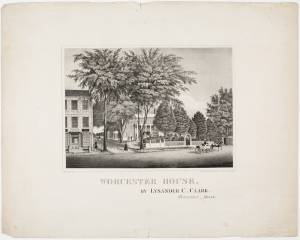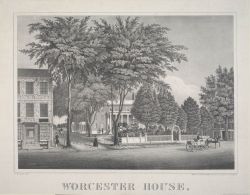loading 
Fitz Henry Lane
HISTORICAL ARCHIVE • CATALOGUE RAISONNÉ • EDUCATIONAL RESOURCE
An online project under the direction of the CAPE ANN MUSEUM
An online project under the direction of the CAPE ANN MUSEUM
Catalog entry
inv. 455
Worcester House
Lithograph on paper 12 5/16 x 13 15/16 in. (31.3 x 35.3 cm) F.H. Lane del.
Moore's Lithography, Boston, successor to Pendleton Collections:
|
Exhibition History
Cape Ann Museum, Gloucester, Massachusetts, Drawn From Nature & on Stone: The Lithographs of Fitz Henry Lane, October 7, 2017–March 4, 2018. [Impression: American Antiquarian Society (inv. 364)].
Published References
Crossman, Carl L. "Lithographs of Fitz Hugh Lane." In American Maritime Prints, edited by Elton W. Hall. New Bedford, MA: The Whaling Museum by the Old Dartmouth Historical Society, 1987, pp. 63–94. The Proceedings of the Eighth Annual North American Print Conference held at the Whaling Museum, New Bedford, Mass., May 6–7, 1977., p. 71. ⇒ includes  text
text
Barnhill, Trafton. Drawn from Nature & on Stone: the Lithographs of Fitz Henry Lane. Gloucester, MA: Cape Ann Museum, 2017., fig. 7, text, p. 15, Worcester House. [Impression: American Antiquarian Society (inv. 364)]. ⇒ includes  text
text
Impression information
American Antiquarian Society (inv. 364)
Printed under image left to right: F.H.Lane del., Moore's Lithography, Boston. / WORCESTER HOUSE / By Lysander C. Clark. / Worcester, Mass.
American Antiquarian Society, Worcester, Mass. (152448)
Provenance
American Antiquarian Society, Worcester, Mass.
Boston Athenaeum (inv. 523)
Printed under image left to right: F.H.Lane del., Moore's Lithography, Boston.
Boston Athenaeum, Gift of Charles E. Mason, Jr., 1973 (1973.25)
Provenance
American Antiquarian Society, Worcester, Mass.
Charles E. Mason, Jr.
Boston Athenaeum, April 1973


Commentary
This urban view drawn by Fitz Henry Lane around 1840 served as an advertisement for Lysander Clark’s newly opened lodgings on Main Street in Worcester. The town was the county seat of Worcester County and had developed its commercial prospects with a turnpike to Boston (1810), a canal to Providence (1828), and a railroad to Boston that opened in 1835.
In his composition, Lane’s understanding of perspective can readily be seen. He also took particular care with the elm trees, differentiating their characteristic branching pattern from that of other specimens. The trees are almost more important to the composition than Worcester House which is set back from the street. The horse and carriage and pedestrians provide a sense of scale.